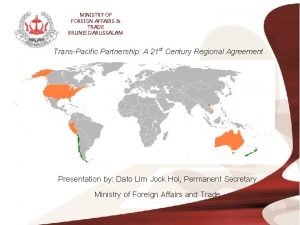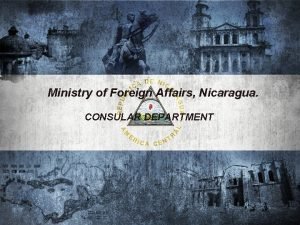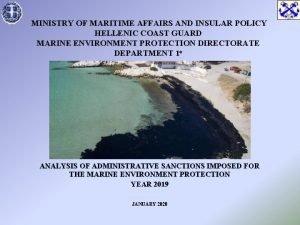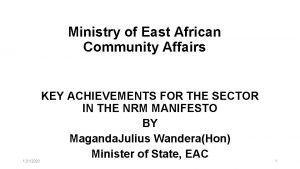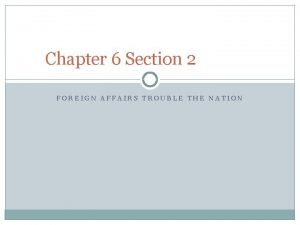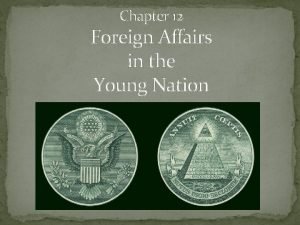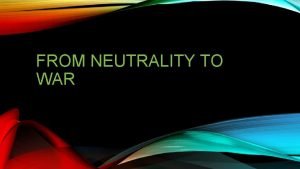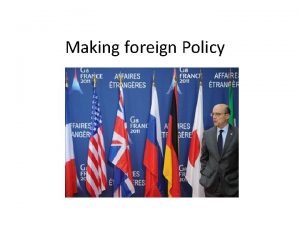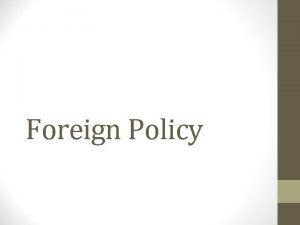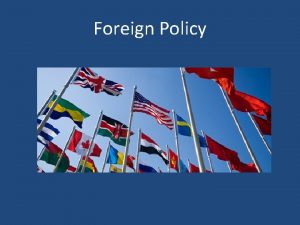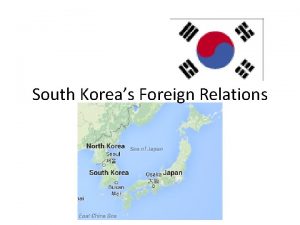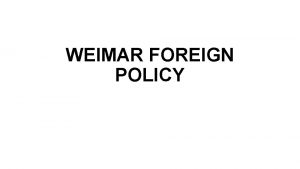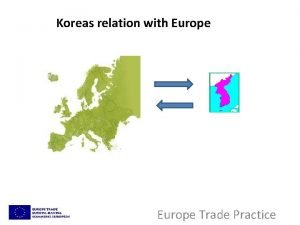Koreas Green Growth Policy Ministry of Foreign Affairs














- Slides: 14

Korea’s Green Growth Policy Ministry of Foreign Affairs and Trade Republic of Korea

Contents I. Background II. Objectives and Actions III. 2010 Mid-term Mitigation Goal IV. Institutional Architecture V. International Cooperation Initiatives VI. Korea's Smart Grid VII. Role of G 20 for Addressing Climate Change

I. Background President Lee Myung-bak put forward “Low Carbon, Climate Green Impact Growth” in 2008. - average temperature rise 1. 7℃ (2 times more than world average) Energy security - 140 billion USD energy bill Economic slow-down - growth rate declining since the Asian economic crisis in late 1990 s - growth without rise in employment 1 “New path is needed”

II. Objectives and Actions National Strategy: 3 policy objectives & 10 key policy items Improvement in Quality of Climate Change Creating New Engines 5 Year Implementation Plan: 107 trillion KRW (86 billion for 2009 Life &USD) Enhancement of Mitigation for Economic Growth 13 Int’l Contribution 1. 2. 3. Effective mitigation of GHG emissions Reduction of the use of fossil fuels and the enhancement of energy independence Strengthening the capacity to adapt to climate change 4. Green Tech R&D 5. The “greening” of existing industries and promotion of green industries 6. Advancement of industrial structure 7. Establishing a structural foundation for the green economy 2 8. Greening the national territory and updating transportation infrastructure 9. Bringing the green revolution into people’s daily lives 10. Becoming a role-model of green growth for the international community

III. 2010 Mid-term Mitigation Goal Set the National Mid-term Reduction Goal (17. November, 2009) Decision Made to Cut GHG Emissions by 30% from BAU by 2020 One of the first non-Annex I countries that made an official announcement on its national reduction goal Announcement of Unilateral and Voluntary Mitigation Goals to Contribute to the Global Mitigation Efforts Accelerating Transition to Low Carbon Green Growth Economy with Implementation of Ambitious Goal Set at the. Unilateral, V Maximum Level of GHG Mitigation oluntary Goal Potential of Korea 3

IV. Institutional Architecture Presidential Commission on Green Growth Framework Act Law for Green Growth § Government to take all the necessary regulatory actions to address climate change, energy security, and sustainable goals § supreme public-private deliberative body to steer the green growth strategy; with a interministerial secretariat Public-Private Consultative Bodies Regional Green Growth Committees § Coordination between the central government and local authorities § Industries, Science and technology, Information technology, finance , and lifestyle Presidential Decree of the Framework Act National Strategy for Green Growth § along with its five year implementation § Including authorizing the Minister of Environment to coordinate all Ministries in pursuing the emissions goal plan (2009 -2013) * Individual Ministries/ Local autonomic administrations should prepare their respective implementation plan 4

V. International Cooperation Initiative Green ODA • Increase from 14% in 2009 to 30% by 2020 • More effective and efficient operation of ODA East Asia Climate Partnership • 2008 – 17 key projects with 7 countries & 4 International organizations • 2009 – 18 new projects Asian Forest Cooperation Organization (AFOCO) • With ASEAN • To share successful experience of Korea’s reforestation program Global Green Growth Institute (GGGI) • To assist countries in formulating their own green growth plans • To serve as a global think tank in leading developing countries to a low carbon society 5

VI. Korea's Smart Grid: Initiative Vision Low Carbon, Green Growth Korea Goals for 2030 Energy Efficiency 46. 7% Compared with 2006 Renewables 2. 4% 11% ’ 30 ’ 08 Percent share 6 PHEV and EVs Deployment 0 ’ 09 Numbers 2. 4 mil ’ 30

VI. Korea's Smart Grid: 5 domains in Roadmap Smart Grid Platform Smart Place Smart Renewables Smart Electricity Market Smart Power Grid 7 Smart Transportation

VI. Korea's Smart Grid: Roadmap Construction of a smart green city Key Objectives Milestones 1 st phase (2009~2012) Jeju Test-bed Project commencement Expansion of smart city (Enabling consumer) Completion of nationwide Smart Grid 2 nd phase (2013~2020) Smart Green city declaration 8 100%AMI penetration Nationwide Smart Grid completed

VI. Korea's Smart Grid: Jeju Test-bed Project Launched in December 2009 Feature of Jeju island as a carbon free island • Abundant renewable energy resources • Excellent reliability separate power system Technologies, business models, and standards proven in Jeju will contribute to international development of Smart Grid 9

VI. Korea's Smart Grid: Technology Action Plan Proposed Smart Grid Working Group and Workstream Key Recommendations Policy, Regulation and Finance Promote horizontal cross-country/ cross-regional partnerships Promote technology and knowledge Transfer technology and Knowledge between developing and developed countries Capacity Building 10 Consumer Engagement Smart Grid Workin g Group Technology and Standards

VII. Role of G 20 for Addressing Climate Change Comprising Major Countries with respect to Climate Change Constructive Input desired - But Supplementary to the UN Process 10

 Ministry of foreign affairs and trade brunei darussalam
Ministry of foreign affairs and trade brunei darussalam Ministry of foreign affairs nicaragua
Ministry of foreign affairs nicaragua Ministry of maritime affairs and insular policy
Ministry of maritime affairs and insular policy Ministry of east african community affairs uganda
Ministry of east african community affairs uganda Hellenic ministry of education and religious affairs
Hellenic ministry of education and religious affairs Foreign affairs trouble the nation
Foreign affairs trouble the nation Foreign affairs in the young nation answer key
Foreign affairs in the young nation answer key Sample letter to minister of foreign affairs
Sample letter to minister of foreign affairs Foreign affairs chapter 15
Foreign affairs chapter 15 Yellow light
Yellow light So here you are too foreign for home
So here you are too foreign for home A national policy of avoiding involvement in world affairs
A national policy of avoiding involvement in world affairs 1790 foreign policy
1790 foreign policy Foreign policy of louis philippe
Foreign policy of louis philippe What was thomas jefferson foreign policy
What was thomas jefferson foreign policy
